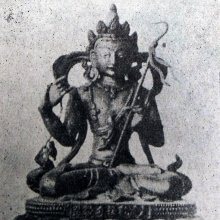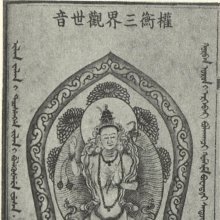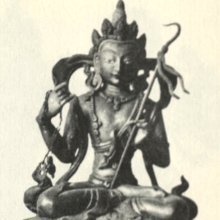Trailokyavashamkara, Trailokyavaśaṃkara, Trailokyavaśaṅkara, Trailokyavashankara: 2 definitions
Introduction:
Trailokyavashamkara means something in Buddhism, Pali, Hinduism, Sanskrit. If you want to know the exact meaning, history, etymology or English translation of this term then check out the descriptions on this page. Add your comment or reference to a book if you want to contribute to this summary article.
The Sanskrit terms Trailokyavaśaṃkara and Trailokyavaśaṅkara can be transliterated into English as Trailokyavasamkara or Trailokyavashamkara or Trailokyavasankara or Trailokyavashankara, using the IAST transliteration scheme (?).
Images (photo gallery)
In Buddhism
Tibetan Buddhism (Vajrayana or tantric Buddhism)
Source: archive.org: The Indian Buddhist IconographyTrailokyavaśaṅkara (त्रैलोक्यवशङ्कर) or Trailokyavaśaṅkaralokeśvara refers to one of the various forms of Avalokiteśvara having their Sādhana described in the 5th-century Sādhanamālā (a collection of sādhana texts that contain detailed instructions for rituals).—His Colour is red; his Āsana is the vajraparyaṅka.—This [Trailokyavaśaṅkara] variety of Lokeśvara is also known by the name of Uḍḍiyāna or Oḍḍiyana Lokeśvara or Lokeśvara as worshipped in Uḍḍiyāna which was, in the middle ages, a great centre of Tantric learning.
The Dhyāna (meditation instructions) of Trailokyavaśaṅkara is described in the Sādhanamālā as follows:
“The worshipper should think himself as Lokeśvara whose limbs are reddened by the intense sentiment of passion, and who is one-faced, two-armed and three-eyed. He wears a crown of matted hair, and carries in his two hands the noose and the goad stamped with the vajra. He is seated on a red lotus in the vajraparyaṅka attitude and is decked in celestial garments and ornaments. Thus meditating...”.
[The Dhyāna, it may be noticed, does not expressly mention the name of Trailokyavaśaṅkara which is given in the colophon. It further says that the Sādhana is composed by the great Tantric savant, Sarahapāda, famous in the Middle Ages as one of the eighty-four Mahasiddhas “Great Mystics”]

Tibetan Buddhism includes schools such as Nyingma, Kadampa, Kagyu and Gelug. Their primary canon of literature is divided in two broad categories: The Kangyur, which consists of Buddha’s words, and the Tengyur, which includes commentaries from various sources. Esotericism and tantra techniques (vajrayāna) are collected indepently.
Languages of India and abroad
Sanskrit dictionary
Source: Cologne Digital Sanskrit Dictionaries: Edgerton Buddhist Hybrid Sanskrit DictionaryTrailokyavaśaṃkara (त्रैलोक्यवशंकर).—(-lokeśvara), name of a deity: Sādhanamālā 79.13 etc.
Sanskrit, also spelled संस्कृतम् (saṃskṛtam), is an ancient language of India commonly seen as the grandmother of the Indo-European language family (even English!). Closely allied with Prakrit and Pali, Sanskrit is more exhaustive in both grammar and terms and has the most extensive collection of literature in the world, greatly surpassing its sister-languages Greek and Latin.
See also (Relevant definitions)
Starts with: Trailokyavashankaralokeshvara.
Full-text: Trailokyavashankaralokeshvara, Uddiyana.
Relevant text
Search found 2 books and stories containing Trailokyavashamkara, Trailokyavaśaṃkara, Trailokyavaśaṅkara, Trailokyavashankara, Trailokyavasamkara, Trailokyavasankara; (plurals include: Trailokyavashamkaras, Trailokyavaśaṃkaras, Trailokyavaśaṅkaras, Trailokyavashankaras, Trailokyavasamkaras, Trailokyavasankaras). You can also click to the full overview containing English textual excerpts. Below are direct links for the most relevant articles:
The Indian Buddhist Iconography (by Benoytosh Bhattachacharyya)
The gods of northern Buddhism (by Alice Getty)
Related products


